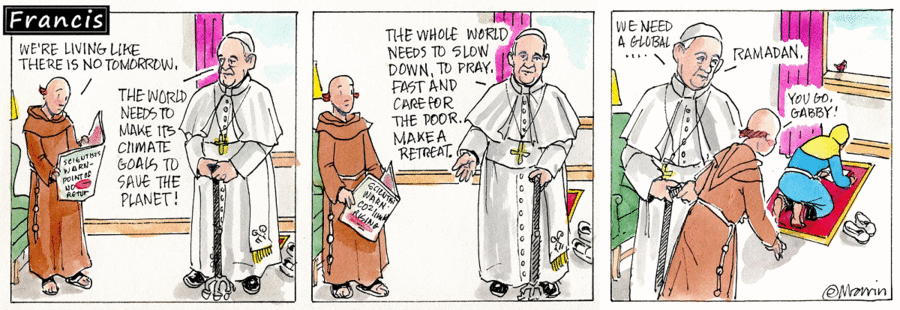Francis (AMS) combines the dread news of the new report from the Intergovernmental Panel on Climate Change with the beginning of Ramadan to make a point about the sudden urge to Do Something as compared to having an ongoing tradition of Doing Something.
Ramadan began this week, but, of course, an observant Muslim like Gabby not only anticipates its coming but lives enough of a disciplined spiritual life throughout the year that it doesn’t come as a shock to the system.
Though I did have a Christian friend who scheduled a lovely vacation trip to Morocco only to discover, to her horror, that it coincided with Ramadan, so that, while she was strolling through the beauties of the land in 100+ degree temperatures, her guides were not simply fasting but were not permitted even a mouthful of water.
However, she reported, there was the compensation of iftar, a large, community meal, at the end of each day.
Iftar is a gift of charity, a spread to which the entire village is invited. Obviously, that’s going to vary depending on where you are and the resources available, but throughout the month-long observance, it’s a constant reminder of the need to be generous and charitable, not in the sense of a command but in the sense of a tradition.
Which brings us, oddly enough, to this Andertoons (AMS), in which the buffalo finds scant comfort in the fact that Indians find a use for every part of him. Which, yes, is a joke and I get it.
Then again, it’s also a myth, because, while the Indians had a use for every part of the buffalo, that doesn’t mean they put every part of every buffalo to every possible use.
Not only did they occasionally stampede a herd off a cliff, resulting in far more mass than they could possibly process, but there were times they’d be on the road and would kill a buffalo to feed the group, but would have neither the time nor the inclination to make thread out of sinews and so forth.
However, if you accept the spiritual setting involved, the buffalo would be willing to be sacrificed for the good of the community, and would be thanked for doing so.
Plus this: At least among the Lakota, it was considered dishonorable to pile up possessions. If you got enough buffalo robes to make a new cover for your tepee, you would give your old cover to someone in the village who did not have a hardy young hunter to provide for them.
And one of the ways in which Crazy Horse gained political power and stature was by being a highly successful horse raider. His skill and daring in this were admired, but, moreso, he was admired for regularly bringing home a string of horses and distributing the bulk of them among less fortunate people.
As with iftar, it was not something done in obedience to a command so much as something done as part of a tradition.
Traditions and commands can blend to become indistinguishable.
Francis Yeats-Brown, author of “Lives of a Bengal Lancer,” returned to India after World War I and reflected on the difference between life in the modern world and life in a world little changed by time.
There is a deep insincerity running through modern Christendom, because the average man and woman who goes to church no longer accepts the Church’s teachings on Heaven, Hell, the reality of the Devil, or the terror of the Wrath of God. We repeat the rich, rolling phrases of the prophets of Palestine, without giving them literal credence and hence we tend to similar hyperbole in our worldly affairs. A civilization that has lost its Faith, cannot keep faith in anything.
Mind you, I’ve known both Muslims and Indians who manage to be perfectly modern without being imperfectly modern. As Francis suggested, we could all use a global Ramadan.
Arctic Circle (KFS) brings up a doubly-relevant point, in part because I just did an on-line search to find the text of Lancer at Large so I could grab that quote, and in part because the Internet Archive is in court over its practice of lending scanned texts, which commercial publishers say deprives them of fair revenues.
I’m not sure why libraries can lend out physical books and the Archive wouldn’t be able to do it with virtual copies.
Pretty sure I’m missing a few details that will emerge in court.
I got a chuckle from this Karl Stevens cartoon because I’ve long since outgrown the notion that publishing popular dreck allows publishers to publish books that not many people are going to want to buy. I’m pretty sure what it allows them to do is to stuff money into their pockets.
As for the direct application to art museums, I recall a particular museum that once mounted major shows of Chagall, Dali, etc. and then ran a Snoopy show, which, as in Stevens’ cartoon, was supposed to underwrite more classical exhibits.
Which were then mounted in a broom closet on the third floor to make space for the popular stuff.
Though not all museums run on that basis: A few years back, I was at a conference in Chicago and found myself with a few hours before the train home, so I went over to the Art Institute to wander around.
The next time I’m in Chicago, I’m bringing a sleeping bag and setting up camp there for a week.
Juxtaposition of the Week
This is a Juxtaposition of the Week, not Day, because I had to search back for the Candorville from the 14th, which had originally triggered my response of “Raggedy Ann and Andy? Do they still make those?”
Which they do. And that’s comforting, because they don’t do anything. They’re just dolls, in a world in which toys are supposed to light up and play music and jump around and then fall apart, leaving little pieces of plastic scattered around the house.
My grandparents had the books, which I guess they had bought for my dad, who was born 102 years ago this coming Tuesday, or possibly his little sister, who wasn’t all that much younger.
I don’t want to see one of the dolls, however. I’d be afraid someone had improved them.








Sorry but Ramadan started yesterday. I’m waiting for the sun to go down right now so I can eat.
You’re right. I was surprised when Alexa gave that later date, since I’d been seeing things about it now. Crazy Alexa! (Thanks — fixed)
What I find most amazing about Raggedy Ann is that it was patented. Gruelle (who incidentally was the newspaper cartoonist “Grue”) received patent USD47789S (1915) for “Design for a doll”. I thought perhaps the patent application would describe something novel, like the face drawing being pre-printed on the fabric. But it doesn’t. It’s simply two drawings of the doll along with the statement that the design is new and original. It doesn’t even mention whether the doll is cloth, wood, metal, ceramic, etc. Just “here’s a doll, it looks like this.”
I find two other similarly (non)descriptive patents awarded to Gruelle. USD47787S for “Design for a toy duck” and USD58314Sfor “Design for a toy animal”. I believe the duck was marketed as part of the Quacky Doodles family.
These don’t seem to be the kind of thing that would qualify for a patent today. Copyright and/or trademark but not patent.
Design patents (USDxxxx) are simply for the design (looks) of something, and I don’t know why one would use a patent rather than copyright or trademark. Design patents are commonly used by tire companies to patent their tread patterns — doesn’t have to demonstrate that the tread has any special properties; only that it has a unique(?) pattern.
At least, that’s what a patent lawyer told me a long long time ago.
Many kinds of design did not qualify for trademark status until the law changed in the 1940s so designers applied for patents instead. This particularly happened with costume jewelry so I wouldn’t be surprised if it applied to dolls also. Jewelry patents were based on the specific look of the pieces as conveyed by drawings and had nothing to do specific mechanisms.
Michael, and everyone else, Eid Mubarak!
Libraries pay for the books they lend, including the e-books. I don’t know whether the Internet Archive pays for its books, but I’ve heard conference presentations by Internet Archive folks and they haven’t mentioned it.
I once heard that Kermit was patented. A quick search with Google doesn’t turn up the number, though.
Henson patented two muppet designs early in his career, one drawing looks similar to Kermit.
https://www.uspto.gov/learning-and-resources/journeys-innovation/historical-stories/reframing-entertainment
I feel so sorry for my Muslim students when Ramadan takes place during the part of the year when the days are long.
“There is a deep insincerity running through modern Christendom, because the average man and woman who goes to church no longer accepts the Church’s teachings on Heaven, Hell, the reality of the Devil, or the terror of the Wrath of God. We repeat the rich, rolling phrases of the prophets of Palestine, without giving them literal credence and hence we tend to similar hyperbole in our worldly affairs. A civilization that has lost its Faith, cannot keep faith in anything.”
What a deeply insulting quote to anyone who is actually religious, and not merely superstitious and hateful.
In what possible way? He’s calling out superficiality and those who go to church but have no real connection to the roots of their scripture. I guess if just showing up on Sunday is all it takes, then he’s insulting people who show up on Sunday. I don’t disagree with him.
Not so insulting as it is sad. I suspect that most who ARE deeply religious recognize that the quote is true and that the majority of “Christians”, especially evangelicals, are in a socio-political movement, not a religion.
Yeats-Brown was observing that much of India, in the 1930s, was like the India of the Bhagavad Gita and the Upanishads, while modern England had little in common with the culture of Palestine in Biblical times. Thus, he argued, modern Western Christians with faucets in their sinks didn’t get the same deep vibe from spiritual references to wells, for instance, that a desert-dwelling people would.
There’s probably a doctoral dissertation in there for someone living in Bangalore today.
Many, not all. Though evangelical, I try to live a life as modeled by Jesus: esteeminng others greater than me, showing love and consideration to all, especially the downtrodden. I would be deemed “woke”.
If you find it insulting, perhaps you should consider why you think he was speaking about you in particular?
“As with iftar, it was not something done in obedience to a command so much as something done as part of a tradition.”
In the Qur’an, the One God commands the faithful to fast until sunset, so if we are all obediently breaking our fast at sunset, the cultural tradition absolutely is done precisely because of the command.
Are you saying that, if it were not commanded, nobody would do it? That’s not the impression I’ve gotten from my Muslim friends. They seem to enjoy being charitable and fulfilling the traditions of their culture.
Well, as you wrote above, “Traditions and commands can blend to become indistinguishable.”
But don’t discount the joy of submission. It’s not one I share, but it’s real, and not restricted to any one religion. Consider the Shaker folk song “‘Tis a Gift to be Simple”:
When true simplicity is gained
To bow and to bend, we will not be ashamed
To turn, turn, will be our delight
‘Til by turning, turning, we come round right
Where, exactly, do you think the tradition comes from? The commandment provides the raison d’etre and because of it the tradition emerges. The fact of commandment does nothing to diminish the beauty of the act, and does much to preserve its integrity. The sense that the commandment comes from the Most High is what preserves it against the ravages of a world that would seek to diminish everything.